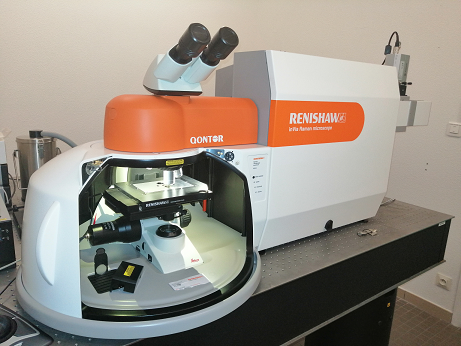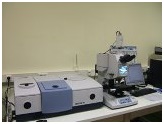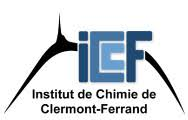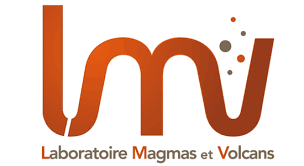Vibrational Spectroscopy
About us
The purpose of this service is to meet the needs of the scientific community for the realization of qualitative and quantitative analyzes of substances (major, traces, syntheses, natural, ...).
Vibrational spectroscopies (Raman and infrared) make it possible to probe the vibrations of the atomic groups in the material. They therefore make it possible to obtain a vibrational impression of the molecule or solid analyzed and thus to identify them. The coupling with microscopes makes it possible to locate the analysis and thus to obtain information on the heterogeneities present within the sample. In particular, automated 3-axis motorized decks make it possible to obtain 2D or 3D (Raman) samples with a good spatial resolution (1 μm in Raman, 10 μm in IR).
Vibrational spectroscopies are adapted to any type of sample (solid, liquid gas) and of any chemical nature (organic, polymer, inorganic, metallic, ....)
By working under a microscope, the amount of sample required is minimal and the possibility of working on thin sections or in capillary allows the study of compounds sensitive to air or humidity. The analyzes are completely non-destructive and generally require no prior preparation on a quantity of material of the order of μg. The preparation time is almost zero.
Vibrational spectroscopies (Raman and infrared) make it possible to probe the vibrations of the atomic groups in the material. They therefore make it possible to obtain a vibrational impression of the molecule or solid analyzed and thus to identify them. The coupling with microscopes makes it possible to locate the analysis and thus to obtain information on the heterogeneities present within the sample. In particular, automated 3-axis motorized decks make it possible to obtain 2D or 3D (Raman) samples with a good spatial resolution (1 μm in Raman, 10 μm in IR).
Vibrational spectroscopies are adapted to any type of sample (solid, liquid gas) and of any chemical nature (organic, polymer, inorganic, metallic, ....)
By working under a microscope, the amount of sample required is minimal and the possibility of working on thin sections or in capillary allows the study of compounds sensitive to air or humidity. The analyzes are completely non-destructive and generally require no prior preparation on a quantity of material of the order of μg. The preparation time is almost zero.
Our services
For internal and external partners:
- provision of the spectrometer (for trained users only)
- Raman and FTIR analysis with presentation of the results
- Preliminary studies
- Expertise with report delivery
- Training
Facilities / Equipments
Raman
The platform is equipped with a RENISHAW brand Invia Kontor Raman spectrometer coupled with a Leica confocal microscope.
The available excitation sources are 532 nm, 785 nm and 1064 nm allowing to analyze a very wide range of samples and materials.
This tool, which is one of the most efficient on the market, allows:
The Magmas et Volcans laboratory has a Fourier Bruker Vertex 70 transform infrared spectrometer with a Hyperion microscope.
The system is equipped with three detectors (MCT, DTGS, Si diode), three lenses (x4, x15 and x36) and polarizers. The analysis is possible in the spectral range 700-7500 cm-1, using CaF2 or KBr optical windows, and OPUS 5.5 software.
The analysis can be performed in transmission or reflection mode; quantification is only possible in transmission mode.
This spectrometer allows the determination of the concentration and speciation of volatiles (H2O, OH-, H2, CO2, CO32-) in minerals and glasses with a minimum spot size of 10 µm.
The method is applied to glasses and high pressure synthetic minerals as well as natural products such as minerals from the Earth’s mantle and vitreous inclusions trapped in magmatic crystals.
The platform is equipped with a RENISHAW brand Invia Kontor Raman spectrometer coupled with a Leica confocal microscope.

The available excitation sources are 532 nm, 785 nm and 1064 nm allowing to analyze a very wide range of samples and materials.
This tool, which is one of the most efficient on the market, allows:
- Work at low frequency up to 50 cm-1 of the excitatory line,
- Very low resolution (< 0.7 cm-1),
- To perform high-resolution 3D imaging on a sample and thus reveal heterogeneities.
- Telescopic arm to analyze liquid, large, or heat sensitive samples.
- A temperature cell allowing the analysis of samples between -196°C and +600°C under argon or nitrogen air flow.
- Optical fiber at 785 nm for in situ analysis of chemical reaction.
- An oil immersion objective to improve the quality of deep mapping.
- Accessories for powder and liquid analysis and sample fixation.

The Magmas et Volcans laboratory has a Fourier Bruker Vertex 70 transform infrared spectrometer with a Hyperion microscope.
The system is equipped with three detectors (MCT, DTGS, Si diode), three lenses (x4, x15 and x36) and polarizers. The analysis is possible in the spectral range 700-7500 cm-1, using CaF2 or KBr optical windows, and OPUS 5.5 software.
The analysis can be performed in transmission or reflection mode; quantification is only possible in transmission mode.
This spectrometer allows the determination of the concentration and speciation of volatiles (H2O, OH-, H2, CO2, CO32-) in minerals and glasses with a minimum spot size of 10 µm.
The method is applied to glasses and high pressure synthetic minerals as well as natural products such as minerals from the Earth’s mantle and vitreous inclusions trapped in magmatic crystals.
Some of our achievements
These characterizations are essential techniques of the Inorganic Materials (MI), Thermodynamics and Molecular Interactions (TIM), Materials for Health (MPS) and Photochemistry teams of the ICCF (evolution of solid material bonds as a function of temperature and pressure in situ), the teams of the LMV and the MINAMAT team of the Pascal Institute. They are also used in many contracts; the ANR CORECAT for which spectroscopy has brought a real added value (determination of the rate of carbon defects serving as electrocatalyst in fuel cells). Infrared and Raman spectroscopies are also commonly used in regional projects, FLUOPLAST is a good example. It is also used in industrial projects for the UCA / CNRS / Orano Joint Research Laboratory (formerly Areva), agri-food industries such as Beauvalet or Carbogen Amcis (validation of the purity of food plastic or industrial mixer), pharmaceuticals such as the CHMP (aid in the detection of counterfeit products), energy such as SAFT or CNES (identification of electrode materials and evolution during in-situ cycling).
Training
Course on vibrational spectroscopies is proposed for students in the Master of chemistry.

Contacts
Scientific leader
Elodie Petit
Tel.: +33(0)4 73 40 54 91
Tel.: +33(0)4 73 40 54 91
Address
Institut de Chimie de Clermont-Ferrand (ICCF), UMR CNRS 6296
Campus Universitaire des Cézeaux
24 avenue Blaise Pascal
TSA 60026, CS 60026
63178 AUBIERE Cedex
France
Campus Universitaire des Cézeaux
24 avenue Blaise Pascal
TSA 60026, CS 60026
63178 AUBIERE Cedex
France


